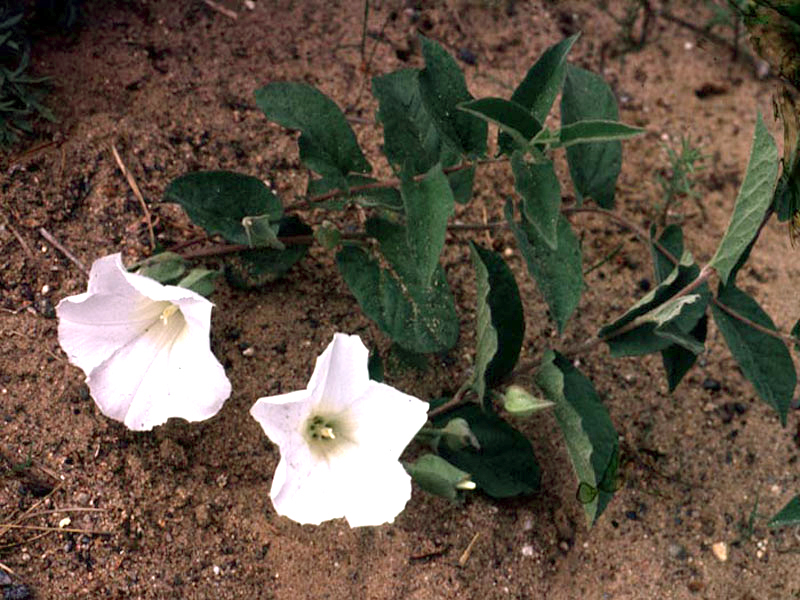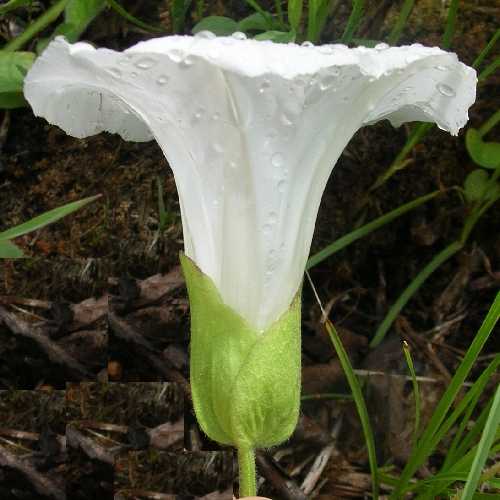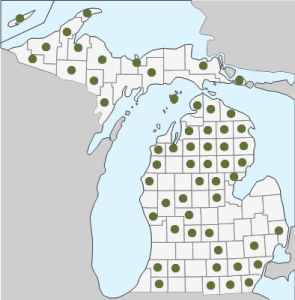 Download PDF
Download PDF
Name: Calystegia spithamaea (L.) Pursh.
Family: Convolvulaceae, the Bindweed or Morning Glory Family
Common Names: low false bindweed, low bindweed, upright bindweed, erect bindweed, dwarf bindweed (1, 10)
Etymology: Calystegia comes from two Greek words: kalux, “cup,” and stegos, “a covering.” The word spithamaea comes from the Latin spithama or the Greek spithame, which means “span,” and refers to it reaching the height of a span (3, 7, 14).
Botanical synonyms (11):
Convolvulus spithamaeus L.
Calystegia spithamaea Pursh
Volvulus spithamaeus Kuntze
Convolvulus camporum Greene
See below for synonyms of the subspecies of this species (11).
Quick Notable Features (11):
¬ low-growing, rhizomatous plant
¬ has a single stem, but may have a few ascending branches
¬ one to four solitary, erect pink to white flowers that can grow quite large and arise from the median to lower leaf axils
Plant Height: The plant only usually grows to a height of 7-50cm (11).
Subspecies/varieties recognized (1):
C. spithamaea (L.) Pursh ssp. purshiana (Wherry) Brummitt [syn: C. sepium (L.) R. Br. var. pubescens Gray, C. spithamaea (L.) Pursh var. pubescens (Gray) C.F. Reed, Convolvulus purshianus Wherry, Convolvulus sepium L. var. pubescens (Gray) Fern., Convolvulus spithamaeus L. var. pubescens (Gray) Fern.]
C. spithamaea (L.) Pursh ssp. spithamaea [syn: Convolvulus spithamaeus L.]
C. spithamaea (L.) Pursh ssp. stans (Michx.) Brummitt
Most Likely Confused with: Calystegia sepium, Convolvulus arvensis, Polygonum cilinode.
Habitat Preference: Plants of this species are usually found in dry, rocky or sandy soil, fields and open aspen, oak and/or jack pine woodland. In these soils it is often on banks, bluffs or clearings where there has been some disturbance. It is sensitive to competition and does well after fires. It is often found with bracken fern (2, 4, 11).
Geographic Distribution in Michigan: C. spithamea ssp. purshiana is not found in Michigan; however, the other two subspecies are. They are found in 42 of 68 counties in the Lower Peninsula and 11 of 15 Upper Peninsula counties. The counties they are not found in are mostly in the thumb area and southwest portion of the Lower Peninsula and the middle of the Upper Peninsula (1).
Known Elevational Distribution: no specific elevation data found yet.
Complete Geographic Distribution: This American native is found in every state east of or adjacent to the Mississippi River except AR, LA, MS and FL (1).
Vegetative Plant Description: The somewhat dense pubescent stems of this perennial herb rarely twine and rarely branch (3). They are erect at least until the flowering portion, then elongating and declining. It is usually a low-growing, rhizomatous perennial. The simple, alternately arranged oblong to obovate leaves are 3-8 cm long, and 2.5-4.5 cm wide. The blade margin is entire, and pinnately veined, with an acute to rounded apex and a truncate to cordate base that meets a short petiole (0.5-2cm), usually less than half the length of the blade (3). The upper leaves are sessile and the lower leaves are very small, while the intermediate leaves are nearly uniform. The leaves are always more or less hairy. Below the calyx are two 15-30 mm sepaloid oblong to ovate bracts, often called an epicalyx (1, 2, 5, 6, 11).
Climbing Mechanism: According to Voss, this species does not actually twine, but its “erect stem may twist a little toward the tip” (4). If it does twine, we suspect it will twine dextrally like others in the genus, but this has not yet been observed.
 Flower Description: The inflorescences are usually solitary, rarely with 2-4 flowers, arising from the lower axils on 4-angled peduncles. The inflorescences are few, but when they do form, the peduncles are 2-8 cm long and produced 5-20 cm above the base of the plant, but below the twisted part of the stem. The five white or pink petals are 4-7 cm long and broad surrounded by five appressed sepals. By inference and comparison with other species in the genus, we assume the stamen number to be 5, but have not confirmed this yet. The superior ovary is more or less unilocular with two oblong, cylindrical, flat stigmas. Below the calyx are two 15-30 mm sepaloid oblong to ovate bracts, often called the epicalyx (2, 5, 11).
Flower Description: The inflorescences are usually solitary, rarely with 2-4 flowers, arising from the lower axils on 4-angled peduncles. The inflorescences are few, but when they do form, the peduncles are 2-8 cm long and produced 5-20 cm above the base of the plant, but below the twisted part of the stem. The five white or pink petals are 4-7 cm long and broad surrounded by five appressed sepals. By inference and comparison with other species in the genus, we assume the stamen number to be 5, but have not confirmed this yet. The superior ovary is more or less unilocular with two oblong, cylindrical, flat stigmas. Below the calyx are two 15-30 mm sepaloid oblong to ovate bracts, often called the epicalyx (2, 5, 11).
Flowering Time: In the central and northeastern United States, and in adjacent parts of Canada, flowering occurs from May to July and can extend into August (7).
Pollinator: Little is known about this species’ pollinator, but it is suggested that “generalists, such as native flies or bees, or even moths” would be the most likely pollinators (11). One genus of bee, Diadasia, uses pollen from species of Calystegia and Convolvulus (12).
Fruit Type and Description: The fruits are capsules, when produced, globose to nearly globose, bilocular, and 1 cm long. Most fruits that are produced are abortive (5, 11).
Seed Description: Two glabrous seeds per fruit. They have impermeable seed coats, which become permeable when exposed to large fluctuations in temperature between day and night or via direct heat from fires (11).
Dispersal Syndrome: The species most commonly spreads vegetatively by rhizomes and it is not known whether it is “capable of successful sexual reproduction in situ.” Fruits have been observed, but are usually abortive. When successful fruits are produced, mammals, wind, and water are the most likely dispersal agents (11, 12).
Distinguished by: Distinguished from Calystegia sepium by very rarely twining, and C. sepium grows up to 3m bearing hastate or sagittate leaves. Convolvulus arvensis has smaller bracts, freely branching stems, and flowers that are smaller (1.5-2 cm) and mostly bloom later in the year (June to September) (11).
The foliage of C. spithamaea is similar to Polygonum convolvulus, however the inflorescences are very different. C. spithamaea bear large, white, showy flowers, while flowers of P. convolvulus are small, green, apetalous, and hardly noticeable (15, pers. obs.).
Other members of the family in Michigan (number species): Calystegia (3), Convolvulus (1), Ipomoea (5), Cuscuta (8) (source 4).
Ethnobotanical Uses: no information yet found.
 Phylogenetic Information: Within the family Convolvulaceae the genus Calystegia is placed in the tribe Convolvuleae according to recent molecular studies. Also included in this tribe are the widespread species of Convolvulus, in which Calystegia previously was included, and the genus Polymeria, endemic to Australia. Within the family, this tribe is closest to the tribe Jacquemontieae (only consisting of the genus Jacquemontia), and both tribes are close to the tribe Aniseieae (including Aniseia, Iseia, Odonellia, and Tetralocularia). The family Convolvulaceae is included in the Solanales, one of the four clades of the Euasterids I, a Core Asterid. Finally, of course, they are Tricolpate Angiosperms (8, 9).
Phylogenetic Information: Within the family Convolvulaceae the genus Calystegia is placed in the tribe Convolvuleae according to recent molecular studies. Also included in this tribe are the widespread species of Convolvulus, in which Calystegia previously was included, and the genus Polymeria, endemic to Australia. Within the family, this tribe is closest to the tribe Jacquemontieae (only consisting of the genus Jacquemontia), and both tribes are close to the tribe Aniseieae (including Aniseia, Iseia, Odonellia, and Tetralocularia). The family Convolvulaceae is included in the Solanales, one of the four clades of the Euasterids I, a Core Asterid. Finally, of course, they are Tricolpate Angiosperms (8, 9).
Interesting Factoids:
- It rarely twines and usually grows upright.
- It is one of the first vascular plants to regenerate after fire, as soon as 100 days after a severe fire.
- It is considered threatened or endangered in CT, MA, ME, NH, NJ and VT (1).
Literature and websites used:
- USDA, NRCS. 2006. The PLANTS Database (http://plants.usda.gov, 8 November 2006). National Plant Data Center, Baton Rouge, LA 70874-4490 USA.
- Gleason, H.A. & A. Cronquist. 1991. Manual of Vascular Plants of Northeastern United States and Adjacent Canada. New York: The New York Botanical Garden Press.
- Brown, R.W. 1956. Composition of Scientific Words. Washington, D.C.: Smithsonian Institution Press.
- Voss, E.G. 1985. Michigan Flora Part III. Ann Arbor, MI: Cranbrook Institute.
- Radford, A.E., H.E. Ahles & C.R. Bell 1968. Manual of the Vascular Flora of the Carolinas. Chapel Hill, N.C.: The University of North Carolina Press
- Cooperrider, T.S. 1995. The Dicotyledoneae of Ohio: Part 2. Linaceae through Campanulaceae. Columbus, OH: Ohio State University Press.
- Fernald, M. L. 1950. Gray’s Manual of Botany, 8th ed. New York: American Book Company.
- Judd, W.S., C. S. Campbell, E.A. Kellogg & P.F. Stevens 1999. Plant Systematics: A Phylogenetic Approach. Sunderland, MA: Sinauer Associates, Inc.
- Stefanovic, S., D.F. Austin & R.G. Olmstead 2003. Classification of Convolvulaceae: A Phylogenetic Approach. Systematic Botany 2(4): 791-806.
- Iverson, L.R., D. Ketzner, & J. Karnes 1999. Illinois Plant Information Network. Database at http://www.fs.fed.us/ne/delaware/ilpin/ilpin.html Illinois Natural History Survey and USDA Forest Service.
- Corrigan, E.E. 2004. Calystegia spithamaea (L.) Pursh. ssp. spithamaea (Low Bindweed) Conservation and Research Plan for New England. Framingham, MA: New England Wildflower Society.
- Austin, D. F. 1997. Convolvulaceae (Morning Glory Family). Published on WWW at <http://www.fau.edu/divdept/biology/people/convolv.htm> (accessed on March 8, 2007).
- Catling, P.M., A. Sinclair, & D. Cuddy. 2001. Vascular plants of a successional alvar burn 100 days after a severe fire and their mechanisms of re-establishment. Canadian Field-Naturalist 115 (2): 214-222.
- Charters, M.L. 2007. California Plant Names: Latin and Greek Meanings and Derivations A Dictionary of Botanical Etymology. http://www.calflora.net/botanicalnames/
- Atland, J. 2000. Weed Identification Guide. Oregon State University http://oregonstate.edu/dept/nursery-weeds/startpage.html
Image Credits:
1) The image of the plant is © Robert W. Freckmann and the University of Wisconsin – Stevens Point.
2) The close-up of the flower is © Merel R. Black and the University of Wisconsin – Stevens Point.
3) Species distribution map, derived from the Michigan Flora Online.
Primary Authors: Marko Melymuka, John Bradtke, and Robyn J. Burnham
For additional information on Michigan Plant Diversity web pages please contact Robyn J. Burnham via email: rburnham“at”umich.edu